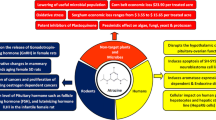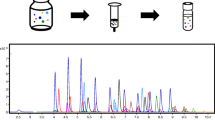Abstract
This study develops and validates a novel analytical approach for the simultaneous determination of 127 polychlorinated biphenyls (PCBs), together with 6 polychlorinated naphthalenes (PCNs) and 16 polycyclic aromatic hydrocarbons (PAHs). PCBs, PCNs, and PAHs were subjected to a unique pretreatment protocol and were simultaneously determined in a single chromatographic run, using GC-MS, in environmental marine samples of mussels and clams. The results of the validation experiments, which were performed on the standard reference materials (NIST SRM 1974C – slurried matrix and NIST SRM 2977 – freeze-dried matrix), were in accordance with the certified and the reference values. The repeatability of the method for all target compounds, expressed as mean relative standard deviations, ranged from 2.5 to 5.1 % for PCBs, from 3.9 to 5.5 % for PCNs, and from 8.6 to 17.9 % for PAHs; the first value of each pair refers to the freeze-dried matrix and the second to the fresh one, for each of the classes of compounds examined. The quantification limits were in the range of 0.2–6 pg for PCBs, 0.4–8 pg for PCNs, and 0.2–15 pg for PAHs (on column). The method recoveries yielded good results (62 ± 19 % for the freeze-dried matrix and 60 ± 14 % for the fresh one) and were not significantly reduced by adopting a single analytical protocol compared with the use of different group-specific analytical methods. No serious interferences were encountered and good selectivity was achieved. These results show that this method allows one to increase the laboratory sample throughput while requiring a small amount of tissue and saving time.

Simultaneous determination of halogenated contaminants and polycyclic aromatic hydrocarbons: a multianalyte method applied to filter-feeding edible organisms

Similar content being viewed by others
References
Erickson MD. Analytical chemistry of PCBs. 2nd ed. Boca Raton: CRC PressCRC Press; 1997.
Safe S. Toxicology and risk assessment of POPs. In: Fiedler H, Ed. Persistent organic pollutants. The Handbook of Environmental Chemistry. Springer-Verlag: Berlin; 2003. Vol. 3, part O, pp. 223–235.
Xua W, Wanga X, Caia Z. Analytical chemistry of the persistent organic pollutants identified in the Stockholm Convention: a review. Anal Chim Acta. 2013;790:1–13.
Van den Berg M, Birnbaum LS, Denison M, De Vito M, Farland W, Feeley M, et al. Review: The 2005 World Health Organization reevaluation of human and mammalian toxic equivalency factors for dioxins and dioxin-like compounds. Toxicol Sci. 2006;2(93):223–41.
Robertson LW, Hansen LG. PCBs: recent advances in environmental toxicology and health effects. Lexington: University Press of Kentucky; 2001.
Meador JP, Stein JE, Reichert WL, Varanasi U. Bioaccumulation of polycyclic aromatic hydrocarbons by marine organisms. Rev Environ Contam Toxicol. 1995;143:79–165.
Baussant T, Sanni S, Skadsheim A, Jonsson G, Børseth JF, Gaudebert B. Bioaccumulation of polycyclic aromatic compounds: 2. Modeling bioaccumulation in marine organisms chronically exposed to dispersed oil. Environ Toxicol Chem. 2001;6(20):1185–95.
Pizzini S, Marchiori E, Piazza R, Cozzi G, Barbante C. Determination by HRGC/HRMS of PBDE levels in edible Mediterranean bivalves collected from north-western Adriatic coasts. Microchem J. 2015;121:184–91.
Bjoërklund E, von Holst C, Anklam E. Fast extraction, clean-up and detection methods for the rapid analysis and screening of seven indicator PCBs in food matrices. TRAC-Trend Anal Chem. 2002;1(21):39–52.
El-Shahawia MS, Hamzaa A, Bashammakhb AS, Al-Saggafa WT. Review: an overview on the accumulation, distribution, transformations, toxicity and analytical methods for the monitoring of persistent organic pollutants. Talanta. 2010;80:1587–97.
Chung SWC, Chen BLS. Determination of organochlorine pesticide residues in fatty foods: A critical review on the analytical methods and their testing capabilities. J Chromatogr A. 2011;1218:5555–67.
Stapleton HM. Instrumental methods and challenges in quantifying polybrominated diphenyl ethers in environmental extracts: a review. Anal Bioanal Chem. 2006;386:807–17.
Reiner EJ, Clement RE, Okey AB, Marvin CH. Review: advances in analytical techniques for polychlorinated dibenzo-p-dioxins, polychlorinated dibenzofurans and dioxin-like PCBs. Anal Bioanal Chem. 2006;386:791–806.
Liu L, Liu Y, Lin J, Tang N, Hayakawa K, Maeda T. Development of analytical methods for polycyclic aromatic hydrocarbons (PAHs) in airborne particulates: a review. J Environ Sci. 2007;19:1–11.
Castells P, Parera J, Santos FJ, Galceran MT. Occurrence of polychlorinated naphthalenes, polychlorinated biphenyls and short-chain chlorinated paraffins in marine sediments from Barcelona (Spain). Chemosphere. 2008;70:1552–62.
U.S. Environmental Protection Agency. Method 1668C: Chlorinated biphenyl congeners in water, soil, sediment, biosolids, and tissue by HRGC/HRMS; 2010.
U.S. Environmental Protection Agency. Method 1625C: Semivolatile organic compounds by isotope dilution GCMS; 1989.
U.S. Environmental Protection Agency. Compendium Method TO-13A: Determination of polycyclic aromatic hydrocarbons (PAHs) in ambient air using gas chromatography/mass spectrometry (GC/MS); 1999.
Piazza R, Gambaro A, Argiriadis E, Vecchiato M, Zambon S, Cescon P, et al. Development of a method for simultaneous analysis of PCDDs, PCDFs, PCBs, PBDEs, PCNs and PAHs in Antarctic air. Anal Bioanal Chem. 2013;2/3(405):917–32.
Kalachova K, Pulkrabova J, Drabova L, Cajka T, Kocourek V, Hajslova J. Simplified and rapid determination of polychlorinated biphenyl ethers, and polycyclic aromatic hydrocarbons in fish and shrimps integrated into a single method. Anal Chim Acta. 2011;707:84–91.
Helaleh MIH, Al-Rashdan A, Ibtisam A. Simultaneous analysis of organochlorinated pesticides (OCPs) and polychlorinated biphenyls (PCBs) from marine samples using automated pressurized liquid extraction (PLE) and power prep™ clean-up. Talanta. 2012;94:44–9.
Kalachova K, Pulkrabova J, Cajka T, Drabova L, Hajslova J. Implementation of comprehensive two-dimensional gas chromatography-time-of-flight mass spectrometry for the simultaneous determination of halogenated contaminants and polycyclic aromatic hydrocarbons in fish. Anal Bioanal Chem. 2012;403:2813–24.
Krauss M, Wilcke W. Polychlorinated naphthalenes in urban soils: analysis, concentrations, and relation to other persistent organic pollutants. Environ Pollut. 2003;1(122):75–89.
Manodori L, Gambaro A, Zangrando R, Turetta C, Cescon P. Polychlorinated naphthalenes in the gas-phase of the Venice Lagoon atmosphere. Atmos Environ. 2006;40:2020–9.
Klotz K, Schindler BK, Angerer J. 1,2-Dihydroxynaphthalene as biomarker for a naphthalene exposure in humans. Int J Hyg Envir Health. 2011;214:110–4.
Taverniers I, De Loose M, Van Bockstaele E. Trends in quality in the analytical laboratory. II Analytical method validation and quality assurance. TRAC-Trend Anal Chem. 2004;8(23):535–52.
Bayarri S, Turrio Baldassarri L, Iacovella N, Ferrara F, di Domenico A. PCDDs, PCDFs, PCBs and DDE in edible marine species from the Adriatic Sea. Chemosphere. 2001;43:601–10.
Perugini M, Cavaliere M, Giammarino A, Mazzone P, Olivieri V, Amorena M. Levels of polychlorinated biphenyls and organochlorine pesticides in some edible marine organisms from the Central Adriatic Sea. Chemosphere. 2004;57:391–400.
Herceg-Romanić S, Kljaković-Gašpić Z, Klinčić D, Ujević I. Distribution of persistent organic pollutants (POPs) in cultured mussels from the Croatian coast of the Adriatic Sea. Chemosphere. 2014;114:69–75.
Corsolini S, Sarà G, Borghesi N, Focardi S. HCB, p, p′-DDE and PCB ontogenetic transfer and magnification in bluefin tuna (Thunnus thynnus) from the Mediterranean Sea. Environ Sci Technol. 2007;41:4227–33.
Li M, Shi S, Wang TG. Identification and distribution of chrysene, methylchrysenes and their isomers in crude oils and rock extracts. Org Geochem. 2012;52:55–66.
Acknowledgments
This work was funded by the Italian Ministry of Education, Universities and Research (MIUR) through the project PRIN (Prot. 2010AXENJ8). Sampling of mussels and clams was funded by the Veneto region (project code: 436/1/6/1686/2012). The authors thank Stefano Zambon for his teaching and trust, Enrico Marchiori, Chiara Sbicego, and Daniela Almansi for their kind support.
Author information
Authors and Affiliations
Corresponding author
Ethics declarations
Conflict of Interest
The authors declare that they have no conflict of interest.
Electronic supplementary material
Below is the link to the electronic supplementary material.
ESM 1
(PDF 1780 kb)
Rights and permissions
About this article
Cite this article
Pizzini, S., Piazza, R., Cozzi, G. et al. Simultaneous determination of halogenated contaminants and polycyclic aromatic hydrocarbons: a multi-analyte method applied to filter-feeding edible organisms. Anal Bioanal Chem 408, 7991–7999 (2016). https://doi.org/10.1007/s00216-016-9897-x
Received:
Revised:
Accepted:
Published:
Issue Date:
DOI: https://doi.org/10.1007/s00216-016-9897-x




